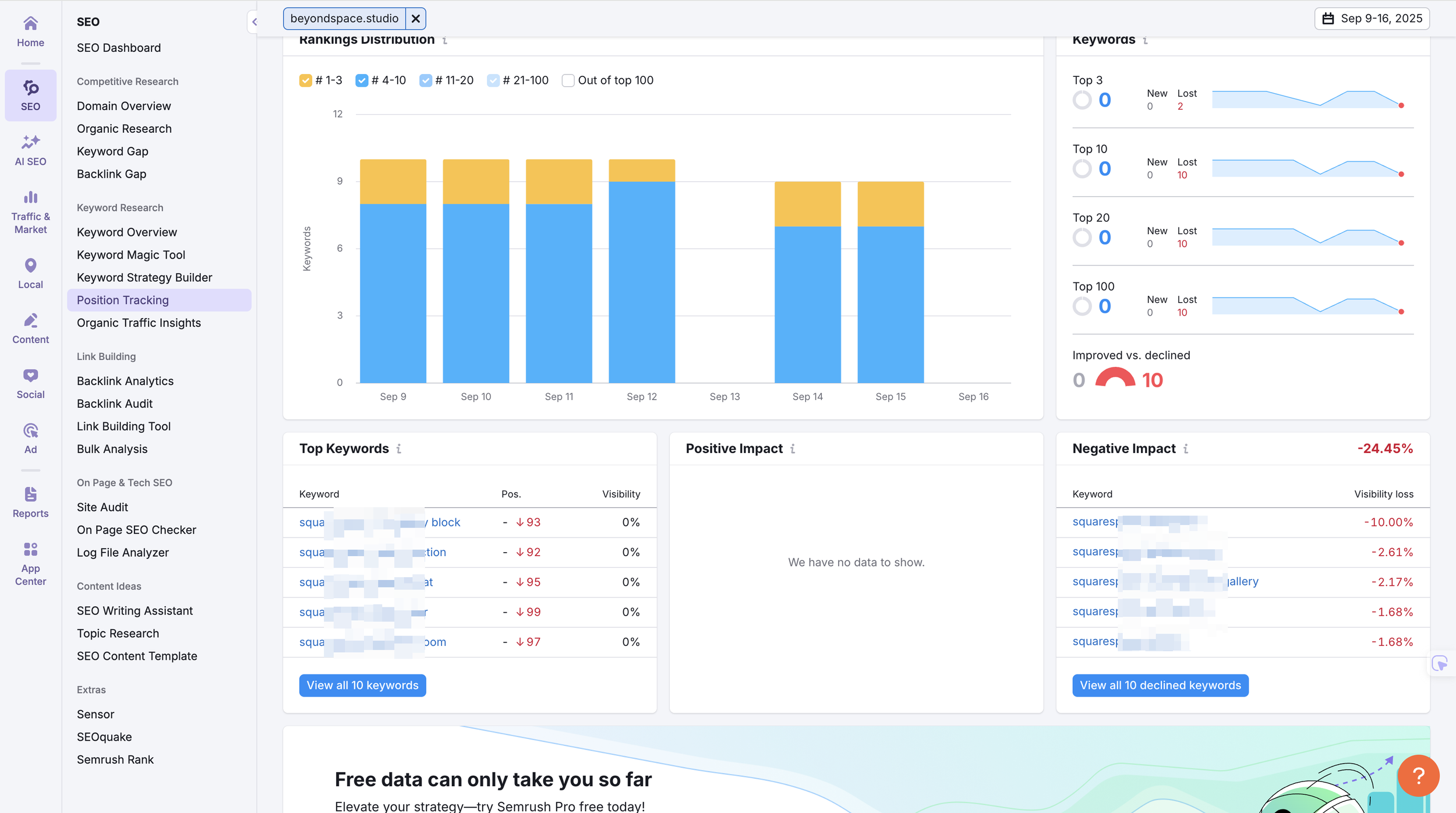Sudden Rankings Drop in Semrush? Here’s Your Sanity-Saving Playbook
You log into your Semrush dashboard, coffee in hand, expecting the usual green arrows and upward trends. Instead, you're hit with a dashboard alert that looks like a horror movie: every tracked keyword is in freefall, and your position graph has gone vertical, straight into the abyss.
Before you panic-launch a full-site audit, take a deep breath. This is a common, albeit heart-stopping, experience for SEOs. While a real algorithm update could be at play, a tool glitch is often the culprit. Here’s a clear-headed, three-step strategy to separate fact from fiction and take action.
Important Update from Semrush (15th September 2025)
Semrush has confirmed on reddit that recent data fluctuations are due to Google removing the &num=100 parameter. This change affects all rank-tracking tools. A temporary solution has been implemented, and Semrush encourages users to check their official announcement for more details.
The removal of this parameter is causing significant discussion in the SEO community, with top industry blogs like Search Engine Land and Search Engine Journal also reporting on the issue and its ripple effects.
For more details:
Step 1: Don't Panic, It’s (Probably) a Glitch
Semrush is a reputable, powerful tool, but it's not a direct line to Google's ranking servers. Its data is a snapshot, not a live feed. Here's why a sudden, site-wide ranking drop might be a data glitch:
Google begins requiring JavaScript for Google Search
Google's Algorithmic Volatility: Google is constantly updating its search algorithm. Sometimes, these changes cause so much SERP volatility that third-party tools can't keep up. For example, during the March 2025 Core Update, the search results fluctuated so wildly that many SEO tools showed temporary and inaccurate data.
The January 2025 JavaScript Update: The most recent change that broke a wide range of SEO tools was Google's January 2025 update, which began enforcing JavaScript for search result pages. This move aimed to protect Google's services from scrapers and automated bots, but it caused a widespread data blackout for popular rank-tracking and SERP analytics tools like SimilarWeb, Rank Ranger, and SE Ranking. Many tools lost the ability to collect live data, resulting in missing reports and database lags across the SEO industry.
A Tool-Specific Bug: On rare occasions, the issue is on Semrush's end. A bug in their data collection or processing can lead to a mass reporting error. A sudden, simultaneous drop of 99+ positions for a large number of keywords is a classic indicator of a tool-related hiccup, not a genuine ranking decline.
Step 2: Use Your Own Judgment (The Only Data That Matters)
To verify if the drop is real, you must go straight to the source: Google.
Google Search Console (GSC): This is your primary source of truth. Log into your GSC account and navigate to the Performance report. Compare the dates of the alleged drop (e.g., September 13, 2025) to your site's performance data. Are your clicks, impressions, and average position truly down? GSC data lags slightly but is the most accurate representation of how Google sees your site.
site:domain.comSearch: This is a simple but powerful check. Go to Google and searchsite:yourdomain.com. This will show you how many pages of your site are indexed and if your site is being penalized. If your index count is still high and your main pages are still showing up, you haven't been de-indexed.Manual Spot-Checking: Perform a few manual searches for your most important keywords. Do your pages still rank on the first page? While not a scalable method, it can provide quick reassurance for your most critical terms.
Google site: search
Step 3: Cross-Reference with Other Tools
If your Semrush dashboard is still showing red and GSC confirms a drop, it's time for a second opinion.
Ahrefs: Ahrefs is a great tool for cross-referencing. Check their Rank Tracker to see if they are showing a similar drop. Ahrefs' keyword database is vast, and their data collection methods can differ from Semrush, so they may be able to confirm or deny the trend.
Mangools (or other alternatives): Mangools' KWFinder and SERPChecker are excellent for live SERP analysis. You can use these tools to manually check the ranking and search volume of your target keywords. If multiple independent tools show a similar decline, you can be more confident that a real drop has occurred.
If the Drop Is Real: Other Tips and Your Action Plan
If your cross-referencing and GSC data confirm a hit, it's time for an audit, not panic.
Wait and See: Don't make a knee-jerk reaction. Major algorithm updates are volatile. A page that drops today could regain its position tomorrow as the dust settles. Give it a week or two before making significant changes.
Conduct a Content Quality Audit: Was your content aligned with Google's E-E-A-T (Experience, Expertise, Authoritativeness, and Trust)? Review the pages that dropped for thin content, lack of unique insights, and outdated information. Look at the new top-ranking pages for your keywords and identify what they are doing differently.
Check Your Technical Health: A rankings drop could also be a symptom of a technical issue. Run a site crawl to check for broken links, crawl errors, or indexing issues. Ensure your site's mobile experience and page speed are flawless.
Review Your Backlink Profile: Has your backlink count changed? Have any high-quality links disappeared? While this is less common with core updates, a manual penalty or a sudden loss of links could cause a drop.
In the world of SEO, data is a powerful tool, but it can also be a significant distraction. A single alert from a third-party tool, regardless of its reputation, should never be the sole reason for a major strategic change. The true health of your site is best measured by Google's own tools and by what you see in real-world search results. Ultimately, SEO is a marathon, not a sprint, and a strong, well-optimized site will always recover.


